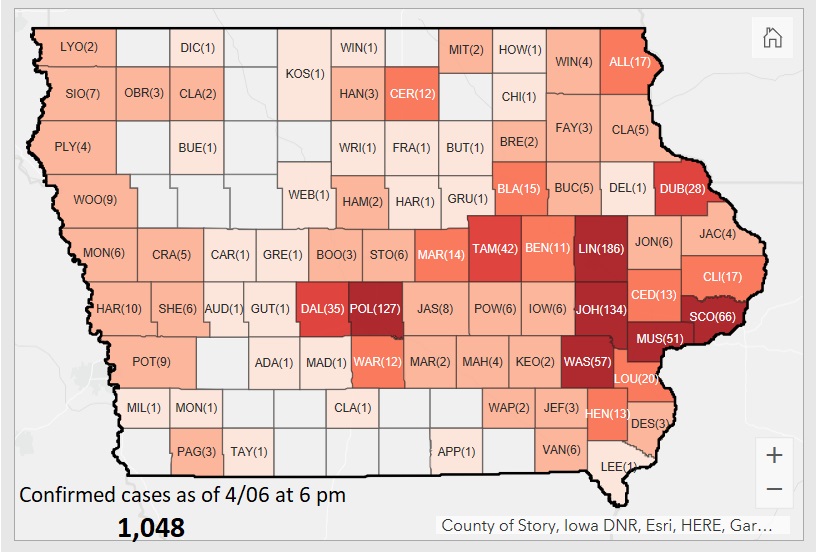Iowa has crossed the 1,000 mark in the COVID-19 pandemic. The Iowa Department of Public Health announced Tuesday that 102 new cases were diagnosed the previous day, bringing the total of 1,048. Of the positive cases, 22 percent are health care workers.
The death toll is now at 26 with the Monday passing of a Benton County resident who was 81 years or older. COVID-19 has been diagnosed at only three of the state’s 439 long term care facilities, but 12 of the deaths – 46 percent of the total – have been in those three facilities.
There have been an additional 1,017 negative tests for a total of 11,670 negative tests to date. Nine percent of those tested have been diagnosed with the virus.
Iowa National Guard Adjutant General Ben Corell spoke at Gov Kim Reynolds’ daily press conference, explaining how the 200-plus IA National Guard troops are involved in the state’s COVID response.
National Guard transportation units have delivered personal protective equipment (PPE) to every county in Iowa. Corell said he has established task force headquarters to support the pandemic response. Additionally, six Regional Medical Coordination Centers have been established in support of IDPH and the Iowa Healthcare Coalition. An RMCC is in each of the six healthcare regions, at the armories in Iowa City, Cedar Rapids, Camp Dodge (Des Moines), Mason City, Council Bluffs and Sioux City.
Regional public health officials, supported by National Guard members, to provide healthcare providers with up-to-date information about immediately available resources, eg. beds, available staffing, PPE, and other “critical healthcare assets.”
“This scaleable capability is a critical resource available to help decision-makers save lives as conditions within the region change and normal response processes are no longer an option,” Corell said.
Reynolds described the role of the RMCCs is to plan for making sure Iowans have the right care at the right time at the right place. She provided detailed information for Region 5, which includes Iowa City, and Region 6, which includes Cedar Rapids. In Region 5, a “hot spot” in the state, only 2 percent of the available ventilators are currently being used. In Region 6, 15 percent of the available ventilators are in use.
Reynolds explained last week the metrics she uses in determining whether to “dial up” or “dial down” mitigation efforts. Using the metrics, the regions are assigned numbers; a score of 10 or more on a scale that goes to 12 would indicate the need for a “stay at home” order, Reynolds said last week.
At the April 7 press conference, she updated those scores. Region 5 is now at a 9. During the Q & A, she was asked what will happen if score goes up; would there be a regional order or a statewide order.
Reynolds answered that the metrics are only a piece of what she and the IDPH are using, and that they’re now “working on what the next step would look like.”
She was also asked what in the metrics would signal the state has “turned the corner” on COVID-19. She answered by reiterating the metrics, but did not answer the question.
The IDPH releases statistics each morning. According to IDPH, the locations and age ranges of the 102 individuals reported as new cases (during the 24 hours preceding April 6 at 6 pm) include:
• Benton County, 1 middle-age adult (41-60 years)
• Black Hawk County, 3 adults (18-40 years)
• Buena Vista County, 1 middle-age adult (41-60 years)
• Delaware County, 1 older adult (61-80 years)
• Des Moines County, 2 older adults (61-80 years)
• Dubuque County, 1 adult (18-40 years), 1 middle age (41-60 years), 1 older adult (61-80 years)
• Greene County, 1 middle-age adult (41-60 years)
• Hamilton County, 1 adult (18-40 years)
• Henry County, 1 child (0-17 years), 1 adult (18-40 years), 2 middle-age adults (41-60 years)
• Johnson County, 10 adults (18-40 years), 4 middle-age adults (41-60 years), 1 older adult (61-80 years), 1 elderly adult (81+)
• Linn County, 4 adults (18-40 years), 5 middle-age adults (41-60 years), 2 older adults (61-80 years)
• Louisa County, 7 adults (18-40 years), 3 middle-age adults (41-60 years), 3 older adults (61-80 years)
• Mahaska County, 1 middle-age adult (41-60 years)
• Marion County, 1 adult (18-40 years)
• Marshall County, 2 adults (18-40 years)
• Muscatine County, 2 children (0-17 years), 3 adults (18-40 years), 3 middle-age adults (41-60 years), 2 older adults (61-80 years)
• Polk County, 1 adult (18-40 years), 1 older adult (61-80 years)
• Pottawattamie County, 1 middle-age adult (41-60 years)
• Scott County, 6 adults (18-40 years), 5 middle-age adults (41-60 years), 3 older adults (61-80 years)
• Story County, 1 middle-age adult (41-60 years)
• Tama County, 3 older adults (61-80 years), 3 elderly (81+)
• Warren County, 1 middle-age adult (41-60 years)
• Washington County, 1 adult (18-40 years), 1 middle-age adult (41-60 years), 2 older adults (61-80 years), 1 elderly (81+)
• Woodbury County, 1 adult (18-40 years) –
–
